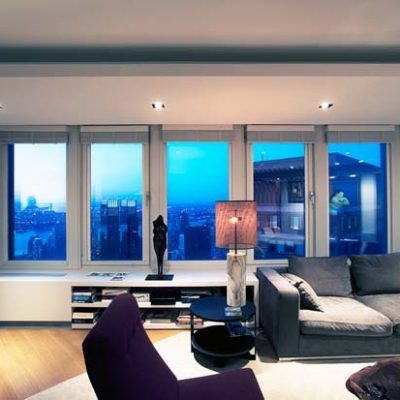
With a commanding view of Columbus Circle and Central Park, this top-floor residence needed to combine cosmopolitan space-coziness with elegance, while using minimal materials and space separations
by Matt Scanlon • photos by Tuca Reinés
Though there are dozens of examples from ancient history of buildings one hundred feet tall or higher, from North America’s La Venta Pyramid (110 feet) constructed in 900 B.C. to the 160- foot Colosseum in Rome (begun in 80 A.D.) to Asia’s Ruwanwelisaya stupa in Sri Lanka (383 feet, 150 B.C.), and of course Egypt’s 4,500-year-old Great Pyramid of Giza, at a still-overwhelming 451 feet. Almost universally, however, tall ancient structures were used for either civic or religious purposes, and not for general habitation. The first instance we know of multiple-story purely residential living are the tower houses of Shibam in Yemen, which date to 1600 A.D. Made of sun-dried mud bricks, they were erected up to seven stories tall—a considerable architectural achievement given the lack of an internal supporting structure—and one wonders at the thrill and wonder felt by the top-floor dweller, sensations largely unchanged in the centuries since.
In designing tall residential buildings, and in redesigning residential spaces within them, architects are posed not just with the challenge of instilling the idea of sanctuary in locations at least conceptually at odds with such a concept, but also with the need to make the most of often compact layouts and square-footage.
In finding ways to completely renovate this top-floor residence overlooking Columbus Circle and Central Park, Spacesmith’s Michel Franck and design architect Arthur Casas devised a plan that would transform the space into a luxurious apartment with modern detailing, and for which attention to detail, color, and furniture selection was critical.
“What appealed to the client about this place was the light and area to display art,” explained Franck. “It was up to us to find the architectural approach to highlight his collection by predominantly designing with a minimal and neutral palette.” The project team created two distinct areas for living and sleeping, using a wood panel that discretely slides into the wall to define the transition. The layout also took full advantage of the building’s diagonal floor plan, optimizing perimeter glazing and minimizing walls.
“The design of the living spaces confirms the sense of openness,” explained design architect Casas, who was also responsible for the selection of the furniture and finishes. “Allowing for the enjoyment of art and the spectacular skyline. Similarly, the
Shaper of cities and fortunes, [the tall building] is the dream, past and present, acknowledged or unacknowledged, of almost every architect. — Ada Louise Huxtable
design of private areas complements the dialogue between interior and exterior spaces—for example the master bathroom tub, which strategically faces Columbus Circle. During the process, which took one year, the owner gave us carte blanche for the work.”
The three-bedroom, three-bathroom apartment lives in just 2,500 square feet, but the firm was at liberty to reconceive it in its entirety, as the previous apartment was “in horrible condition,” recalled Casas. “And we designed the entire floor plan basically from zero. It was a huge renovation.”
Casas’s concept was to design a cosmopolitan space, using minimal materials, mainly oak for floor and panels to compliment the artwork. That palette, he offered, also emphasized minimal and “masculine” colors like burgundy for the living room armchair and light brown for the sofa.
Client needs apart from a curated showplace were that they would entertain friends for drinks occasionally, but not as much for dinner, as the residence is a second home.
Therefore, the kitchen was not given extraordinary consideration by Spacesmith, though the wine cellar and bar is “a very important focal point,” the architect explained. “It’s not an apartment to do business or to receive more than some friends. It’s mainly a place for the family in the city.”
Second homes have, perforce, a certain degree of literal and figurative detachment, and in the wrong hands can often assume hotel-like characteristics, but Casas was at pains throughout to produce a residence that is “a timeless place…cozy and elegant. It looks like their primary home, although it’s not.”
Spacesmith
One New York Plaza, Suite 4200, Manhattan
212-620-5583 / spacesmith.com









